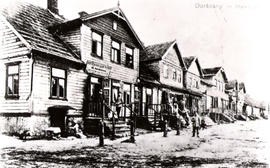During the period of 1890 to 1930 a great migratory movement took place in Europe (particularly Eastern and Southern Europe). Jewish people fled to other countires due largely to economic hardship and political persecution. South Africa received a large influx of these immigrants with the largest Jewish population in South Africa being of Lithuanian heritage [https://kehilalinks.jewishgen.org/capetown/Jews_in_SA.html].
The large Lithuanian and Surrounding Towns Collection includes photographs taken from towns in Eastern Europe that existed for years prior to, and during, the first half of the 20th century. This collection primarily includes towns that fell under what was previously the Grand Duchy of Lithuania, and in interwar years traded titles as part of various powers, but settled into Independent Lithuania after the fall of the Soviet Union. However, there are also some towns that are from surrounding Eastern European countries, all of which had some connection to the Soviet Union, and which had very similar characteristics to the Lithuanian towns in this collection. These towns had considerable Jewish populations, either in number or in presence, referring here to significant Jewish cultural and religious contributions. These photographs have been preserved by survivors of the Holocaust, or by family members of survivors, and have been donated for the purpose of educating and providing comfort to those interested in or invested in the lives of East European Jewry.
Each town is named according to the moniker for that town in Lithuanian, or in the language of the country that the town in question falls under.
In the Series Description for each town, alternative names are given, for ease of reference and for contextual clarity. The number of alternate names is limited to Eastern European countries and Russia, due to the commonplace act in the first half of the twentieth century for these towns to pass from one occupying country to another. This is particularly true for occupation by Russia (then the Soviet Union), and Poland, thus justifying these as the most common alternative provided. Further, being primarily Jewish towns (plural: shtetlekh; singular: shtetl), the Yiddish name is given if it has been identified. This information was sourced from JewishGen, using the Communities page, which provides historical, current and alternative names for various towns. [Source: https://www.jewishgen.org/Communities/Search.asp].
Interconnections between towns, with family and community ties were an extremely important factor deciding where Jewish communities lived and spent time in terms of school and work. This extended from within the little town (referred to as a shtetl in Eastern Europe), to in between shtetlach (plural of shtetl). [Source: https://avotaynuonline.com/2007/01/the-ties-that-bind-jewish-kinship-networks-and-modernization-in-darbenai-and-its-diaspora/]. There has been an attempt to illustrate some of these linkages, with examples of movement between towns and strong community and inter-organisational activities, demonstrating the strength and significance of Jewish life in Eastern Europe.
Importantly, although not always visible in the photographs, various stages of occupation and reoccupation by different powers throughout this period meant conditions for Jewry in these towns could change significantly from one day to the next. Some towns have larger treasure chests of tangible memories in photograph form, while others were unable to preserve as much.
The general pattern of occupation for most of these towns in Lithuania went as follows: The Russian Empire controlled Lithuania until the outbreak of World War I. Bolsheviks (the Red Army) occupied many Lithuanian towns during WWI, which was accompanied by a decree from the Tsar that all Jews were to be exiled deep into the interior of Russia. After the Russian Empire fell at the end of WWI, some of these exiled Jews could return to their original shtetl, but many did not due to having emigrated or died in the transit or by more cruel means. This meant the Jewish population had already begun to decline by the First World War.
During the period of the Independent Republic of Lithuania between WWI and the Second World War, while Jews had some community leadership positions, anti-Semitism was generally quite violent. This Independence was disrupted by Soviet invasion in 1940, which saw the confiscation and nationalisation of economic resources and new governance of these towns. Since Soviet rule had anti-Semitic tendencies, but not necessarily murderous ones, and since some Jews were supportive of communism as part of their Zionist or Bundist ideologies, many Lithuanian nationalists perceived Soviet rule as being beneficial to Jews and saw Jews as supportive of Soviet occupation. Therefore, when Nazis occupied in 1941 at the beginning of war between the Soviet Union and Nazi Germany, many Lithuanian citizens turned against their Jewish neighbours and either orchestrated or collaborated in massacres of Jews.
Lithuanians saw Jews as threats to their independence in many instances, and saw Nazis as more amenable to allowing Lithuania to govern itself compared to Soviets, and thus Lithuanians were likely to collaborate with Nazis. This is one of the reasons that such a large proportion of Lithuanian Jewry were killed during the Holocaust, as Nazis were not acting alone and were not met with resistance from local non-Jews in many instances. There were periods of mass exodus from Lithuania, whereby some Jews were able to escape in between occupations, or during occupation when borders were still open, with most Jews from Lithuania immigrating to South Africa, America and Israel. [Source: https://www.jewishgen.org/yizkor/pinkas_lita/pinkas_lita.html; https://www.jewishgen.org/yizkor/lithuania6/lit6_00i.html#Pagexxxivhttps://www.jewishgen.org/yizkor/lithuania6/lithuania6.html#TOC]
Whenever possible research has been conducted to enrich the information in these collections, if you would like to add any additional information please contact us.










